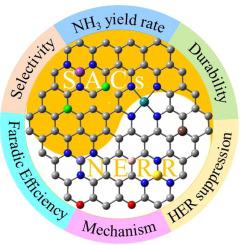当前位置:
X-MOL 学术
›
Mater. Today
›
论文详情
Our official English website, www.x-mol.net, welcomes your
feedback! (Note: you will need to create a separate account there.)
Single-atom catalysts boost nitrogen electroreduction reaction
Materials Today ( IF 21.1 ) Pub Date : 2020-09-01 , DOI: 10.1016/j.mattod.2020.03.022 Yanling Zhai , Zhijun Zhu , Chengzhou Zhu , Kyle Chen , Xueji Zhang , Jing Tang , Jun Chen
Materials Today ( IF 21.1 ) Pub Date : 2020-09-01 , DOI: 10.1016/j.mattod.2020.03.022 Yanling Zhai , Zhijun Zhu , Chengzhou Zhu , Kyle Chen , Xueji Zhang , Jing Tang , Jun Chen

|
Ammonia (NH3) is mainly produced through the traditional Haber-Bosch process under harsh conditions with huge energy consumption and massive carbon dioxide (CO2) emission. The nitrogen electroreduction reaction (NERR), as an energy-efficient and environment-friendly process of converting nitrogen (N2) to NH3 under ambient conditions, has been regarded as a promising alternative to the Haber-Bosch process and has received enormous interest in recent years. Although some exciting progress has been made, considerable scientific and technical challenges still exist in improving the NH3 yield rate and Faradic efficiency, understanding the mechanism of the reaction and promoting the wide commercialization of NERR. Single-atom catalysts (SACs) have emerged as promising catalysts because of its atomically dispersed activity sites and maximized atom efficiency, unsaturated coordination environment, and its unique electronic structure, which could significantly improve the rate of reaction and yield rate of NH3. In this review we briefly introduce the unique structural and electronic features of SACs, which contributes to comprehensively understand the reaction mechanism owing to their structural simplicity and diversity, and in turn expedite the rational design of fantastic catalysts at the atomic scale. Then, we summarize the most recent experimental and computational efforts on developing novel SACs with excellent NERR performance, including precious metal-, nonprecious metal- and nonmetal-based SACs. Finally, we present challenges and perspectives of SACs on NERR, as well as some potential means for advanced NERR catalyst.
中文翻译:

单原子催化剂促进氮电还原反应
氨(NH3)主要通过传统的哈伯-博世工艺在恶劣的条件下生产,能耗巨大,二氧化碳(CO2)排放量大。氮电还原反应 (NERR) 作为一种在环境条件下将氮 (N2) 转化为 NH3 的节能环保工艺,被认为是 Haber-Bosch 工艺的有前途的替代方案,并在最近引起了极大的兴趣。年。尽管取得了一些令人振奋的进展,但在提高 NH3 产率和法拉第效率、了解反应机理和促进 NERR 的广泛商业化方面仍存在相当大的科学和技术挑战。单原子催化剂(SAC)因其原子分散的活性位点和最大化的原子效率、不饱和配位环境及其独特的电子结构而成为有前景的催化剂,可显着提高NH3的反应速率和产率。在这篇综述中,我们简要介绍了 SAC 独特的结构和电子特征,由于其结构的简单性和多样性,这有助于全面了解反应机理,进而在原子尺度上加速对奇妙催化剂的合理设计。然后,我们总结了开发具有优异 NERR 性能的新型 SAC 的最新实验和计算工作,包括基于贵金属、非贵金属和非金属的 SAC。最后,
更新日期:2020-09-01
中文翻译:

单原子催化剂促进氮电还原反应
氨(NH3)主要通过传统的哈伯-博世工艺在恶劣的条件下生产,能耗巨大,二氧化碳(CO2)排放量大。氮电还原反应 (NERR) 作为一种在环境条件下将氮 (N2) 转化为 NH3 的节能环保工艺,被认为是 Haber-Bosch 工艺的有前途的替代方案,并在最近引起了极大的兴趣。年。尽管取得了一些令人振奋的进展,但在提高 NH3 产率和法拉第效率、了解反应机理和促进 NERR 的广泛商业化方面仍存在相当大的科学和技术挑战。单原子催化剂(SAC)因其原子分散的活性位点和最大化的原子效率、不饱和配位环境及其独特的电子结构而成为有前景的催化剂,可显着提高NH3的反应速率和产率。在这篇综述中,我们简要介绍了 SAC 独特的结构和电子特征,由于其结构的简单性和多样性,这有助于全面了解反应机理,进而在原子尺度上加速对奇妙催化剂的合理设计。然后,我们总结了开发具有优异 NERR 性能的新型 SAC 的最新实验和计算工作,包括基于贵金属、非贵金属和非金属的 SAC。最后,











































 京公网安备 11010802027423号
京公网安备 11010802027423号